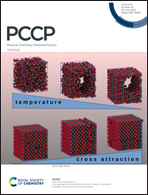The spin caloritronic transport properties of newly designed devices consisting of a sawtooth graphene nanoribbon and its derived five-member ring structure
Abstract
Achieving high spin polarization transport and a pure spin current is particularly desired in spintronics. We use a sawtooth graphene nanoribbon (STGNR) and its derived five-member ring structure (5-STGNR) to design new spin caloritronic devices, since they have been successfully prepared experimentally and have an interface with no lattice distortion. By using first-principle calculations combined with the non-equilibrium Green's function approach, we have studied the spin caloritronic transport properties of several STGNR-based devices, including the structures with symmetrical and asymmetrical edges, and found some excellent spin caloritronic properties, such as spin polarization, magnetoresistance and the spin Seebeck effect. By introducing a temperature difference, giant magnetoresistance and spin Seebeck effects are achieved in a heterojunction with a symmetrical edge, whereas spin polarization is more effective in a heterojunction with an asymmetrical edge. Meanwhile, the metal–semiconductor–metal junction, which is composed of STGNRs with a symmetrical edge, exhibits approximately 100% spin polarization and produces a perfect thermally induced pure spin current at room temperature. Our results indicate that the devices consisting of a sawtooth graphene nanoribbon and its derived five-member ring structure are promising novel spin caloritronic devices.



 Please wait while we load your content...
Please wait while we load your content...